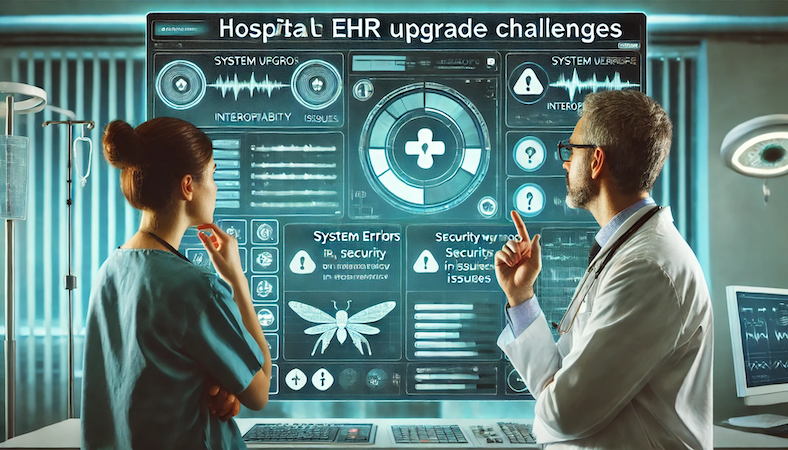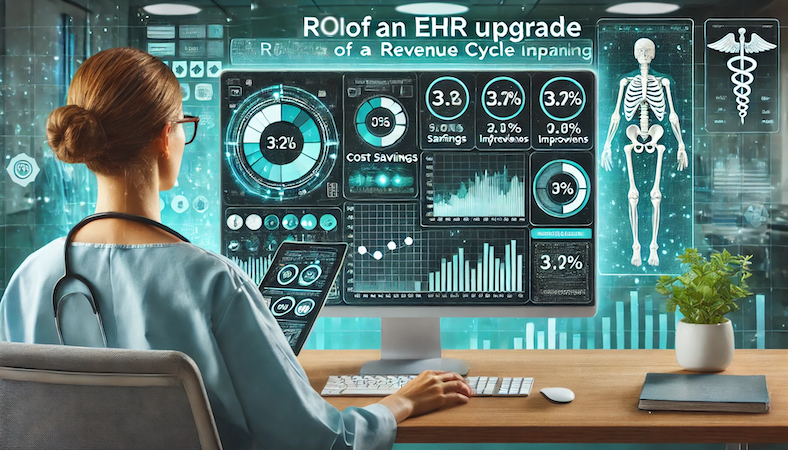If your EHR system were a car, would it be a sleek, self-driving EV—or a gas-guzzling relic that stalls at every intersection? For many healthcare organizations, an EHR upgrade is long overdue, yet the process is often delayed until inefficiencies snowball into full-blown operational nightmares. Clinicians are drowning in clicks, interoperability issues make data sharing a scavenger hunt, and cybersecurity threats loom like storm clouds.
But upgrading your EHR doesn’t have to be a drawn-out, budget-draining ordeal. With the right strategy (and the right partner), it can be a seamless transition toward improved efficiency, stronger security, and better patient care. Here’s how.
Key Takeaways
- Hidden costs in EHR software upgrades often exceed initial estimates by 25-30%
Budget overruns are a common pitfall, often due to underestimating data migration, training, and third-party integrations. A well-planned upgrade mitigates these risks by clearly defining scope and leveraging consultants experienced in cost containment.
- Interoperability failures can make upgrading an EHR more disruptive than beneficial
Without standardized APIs like FHIR, hospitals risk compatibility issues that slow down workflows instead of improving them. Organizations that prioritize interoperability from the start see up to 50% fewer tech complaints post-upgrade.
- The best way to upgrade electronic health records without major downtime is phased implementation
A staggered rollout, starting with non-critical departments, minimizes disruptions and allows iterative refinements. Healthcare systems using this approach report 30% faster staff adoption and smoother transitions.
Table of Contents
- 5 Signs That It’s Time to Upgrade Your EHR
- Key Benefits of Upgrading Your EHR System
- Challenges to Expect During an EHR Upgrade
- Best Practices for a Smooth EHR Upgrade
- The ROI of an EHR Upgrade—What’s the Payoff?
- How to Choose the Right EHR Upgrade for Your Practice?
- How Topflight Can Help?
5 Signs That It’s Time to Upgrade Your EHR
Listen, we’ve all seen this movie: your trusty EHR, once cutting-edge, now feels like the software equivalent of running Windows XP in a world that’s long moved onto the cloud.
The warning signs might seem subtle at first—frustrated sighs from clinicians grappling with endless Epic EHR updates, rising support tickets from interoperability headaches between your EHR and critical health solutions like revenue cycle management platforms or telemedicine apps. Often, these issues stem from outdated EHR software development practices that haven’t kept pace with evolving interoperability standards, making every system update feel like a new battle rather than a step forward.
Declining IT ROI and Rising Clinician Burnout
First red flag? Your ROI on IT spend has taken a nosedive. According to a recent KLAS Research report, healthcare organizations struggling with outdated EHRs face productivity dips as high as 30%. Ouch. Couple that with medical professionals spending up to two extra hours per shift wrangling sluggish systems (hello, burnout), and you’ve got yourself a compelling case for an EHR upgrade.
Persistent Interoperability Headaches
Then there’s interoperability—or rather, the lack of it. A 2023 Black Book survey found that 83% of hospitals cited interoperability hurdles between their primary EHR (like Epic) and supplementary digital solutions as their top tech headache. If your EHR can’t smoothly integrate with other essential platforms, patient care quality and operational efficiency suffer.
Many hospitals struggle with integrating with Epic EHR/EMR, often facing delays in data exchange between different platforms. Without a robust EHR implementation strategy, these gaps in connectivity can lead to patient care disruptions and administrative inefficiencies.
Growing Cybersecurity Risks and Regulatory Pressures
Add rising cybersecurity threats (ransomware attacks on healthcare jumped 94% last year, per Sophos) and constant regulatory shifts like the 21st Century Cures Act and emerging frameworks like TEFCA demanding seamless, secure patient-data exchange, and suddenly, sticking with outdated tech feels less like caution and more like negligence.
In short, here’s your cheat sheet—the top 5 signs that an EHR upgrade can’t wait:
- Sharp decline in IT ROI.
- Growing clinician frustration and burnout due to outdated systems.
- Frequent interoperability issues between EHR and critical healthcare software (e.g., RCM or telemedicine platforms).
- Increased vulnerability to cybersecurity threats.
- Difficulty meeting new regulatory standards (21st Century Cures Act, TEFCA).
Spotting these signs isn’t paranoia—it’s pragmatism. Recognizing when it’s time to pivot doesn’t just keep regulators happy; it frees clinicians from tech-induced torment, safeguarding patient care quality and your organization’s bottom line.
Key Benefits of Upgrading Your EHR System
Look, I get it—upgrading your EHR software feels about as exciting as switching from one dentist to another. But if done right, the ROI payoff is massive, and your clinicians will thank you (maybe even publicly—no promises though).
Improved Revenue Cycle Management
A streamlined EHR upgrade directly enhances your revenue cycle management by automating administrative tasks that previously sapped your billing team’s productivity. According to a recent report by MGMA, practices that undergo comprehensive EHR software upgrades see up to a 15% increase in revenue collections due to reduced claim denials and accelerated payment processing.
Enhanced Clinician Efficiency
Clinicians didn’t slog through medical school to spend half their shift fighting outdated software. Upgraded EHRs, especially cloud-native solutions, cut down unnecessary administrative tasks by as much as 40%, directly tackling burnout by freeing clinicians to spend more time with patients (or grabbing a desperately needed coffee).
- Reduced administrative tasks, minimizing time spent clicking through clunky interfaces.
- Streamlined clinical workflows, giving clinicians more bandwidth to focus on patient care.
Greater Interoperability
Upgraded systems using modern, standardized APIs (FHIR-based, anyone?) ease the friction between your EHR and key platforms like telemedicine tools or AI bots. In fact, a 2023 HIMSS survey revealed that hospitals using modern EHR platforms report up to 50% fewer EHR interoperability complaints, significantly improving efficiency across your digital health stack.
Advanced Patient Care Outcomes
Better tech isn’t just a backend perk; it translates directly to enhanced patient care. Becker’s Hospital Review recently highlighted that organizations leveraging telemedicine capabilities integrated directly into upgraded EHR systems saw patient engagement scores jump as much as 30%.
- AI-driven EHR insights boost early detection, improving patient care
- Integrated telemedicine enhances patient engagement and satisfaction
- Real-time patient monitoring reduces hospital readmissions
Strengthened Security to Protect Medical Records
Cyber threats aren’t hypothetical—they’re headline news. IBM Security’s annual “Cost of a Data Breach Report” pegged healthcare data breaches at an average cost of $10 million per incident. Robust security embedded in newer EHR upgrades significantly reduces vulnerability to cyberattacks, making security investments far more palatable than explaining breaches to stakeholders.
Upgrading your EHR software isn’t just smart—it’s strategic. It improves your revenue cycle, frees clinicians from IT-induced misery, boosts interoperability, transforms patient care outcomes, and keeps cybersecurity incidents out of your nightmares. Win-win, right?
Challenges to Expect During an EHR Upgrade
Let’s not sugarcoat this—upgrading your EHR isn’t exactly a walk in the park. It’s more like navigating a maze blindfolded while stakeholders constantly whisper, “Are we there yet?” Even a straightforward tech upgrade can quickly spiral into complexity.
Here’s your quick-hit list of potential roadblocks:
- Budget constraints and unexpected cost overruns
- Extended implementation timelines affecting patient care
- Complex migration of medical records
- Staff resistance and training difficulties
- Heightened interoperability and cybersecurity risks
Budget Constraints and Cost Overruns
Upgrading EHR systems often includes hidden costs that creep up faster than spam emails. A recent Black Book survey found that nearly 70% of hospitals experience unexpected cost overruns during EHR upgrades, typically 25-30% above initial estimates. From extra training to unforeseen integration costs with platforms like Cerner EHR, these expenses quickly add up.
Risks of Prolonged Implementation
No one enjoys explaining prolonged downtime to frustrated clinicians or anxious patients. A poorly managed EHR implementation can severely disrupt operations, delaying patient care and lowering productivity. HealthTech Magazine reports nearly half of EHR upgrades overshoot initial timelines by at least 30%, directly impacting care quality.
Complexity of Medical Records Migration
Transferring medical records from legacy systems isn’t simple drag-and-drop. Data integrity issues frequently occur, alongside interoperability headaches post-migration if integration points aren’t meticulously planned. Ensuring data consistency during transitions from platforms like Cerner or Epic requires detailed preparation.
Staff Training and Adoption Challenges
Upgrades disrupt established workflows—plain and simple. The American Medical Association notes productivity drops around 20% immediately after upgrading EHR due to workflow disruptions. Mitigate resistance proactively with tailored training and continuous feedback loops.
Interoperability and Cybersecurity Threats
Don’t underestimate cybersecurity risks during upgrades. Robust security throughout the transition phase is critical.
Another often-overlooked factor in the upgrade process is the EHR implementation cost. Beyond the initial price tag, organizations must consider expenses related to training, EHR data migration, and integration with third-party applications. A well-planned approach to budgeting and resource allocation can help mitigate these costs and ensure a smoother transition.
Best Practices for a Smooth EHR Upgrade
Let’s face it—no one enjoys the chaos of a messy EHR upgrade. The right strategy can transform what could be a stressful disruption into a well-managed upgrade delivering lasting improvements.
Here’s how you can navigate the process smoothly, keep your sanity (mostly) intact, and leverage EHR integration services to ensure seamless connectivity across your healthcare IT ecosystem.
Strategic Planning and a Thorough Implementation Roadmap
Jumping headfirst into upgrading an electronic health record without a detailed roadmap is like driving cross-country without GPS—you might eventually get there, but the journey won’t be pretty.
- Develop a realistic timeline with clear milestones.
- Create contingency plans for potential disruptions.
Gartner emphasizes healthcare organizations following structured implementation plans see up to 60% fewer delays.
Engage Experienced EHR Consultants Early
Getting an EHR consultant involved early isn’t just smart—it’s essential. Consultants with a proven track record in EHR optimization offer critical insights on vendor selection, integration strategies, and best practices that internal teams might overlook.
Their involvement can shave weeks or even months off implementation timelines, significantly enhancing overall project ROI.
Effective Data Migration to Minimize Downtime
Updating records isn’t a drag-and-drop affair—it’s a complex ballet of extraction, validation, and reintegration.
- Conduct rigorous data testing before migration.
- Schedule phased migrations during low-demand periods.
- Implement thorough data validation checkpoints.
According to recent reports, structured EHR data migration strategies can reduce downtime by up to 30%. When executed correctly, this disciplined approach transforms what could be a chaotic process into a smoothly choreographed upgrade.
Training Strategies to Speed Clinician Adoption
If your clinicians are skeptical about the new system, they’ll resist—period. Counteract resistance with targeted training, clear communication of tangible benefits, and dedicated super-users who support peers through transition periods.
Continuous feedback loops and incremental training have shown to reduce adoption resistance by up to 40% (American Medical Association).
Prioritize Security Throughout Implementation
With cybersecurity incidents costing healthcare providers millions, robust security is non-negotiable during an upgrade. Prioritize security measures at every step.
- Conduct rigorous security assessments at each stage
- Regularly perform penetration testing and vulnerability scans
Follow these best practices, and your EHR upgrade becomes a strategic leap forward—not another logistical headache.
The ROI of an EHR Upgrade—What’s the Payoff?
Upgrading your EHR isn’t a minor facelift—it’s a strategic investment. But let’s cut to the chase: budgeting accurately to upgrade an EHR is notoriously tricky, with hidden costs lurking behind every corner.
Common overlooked expenses include:
- Extensive staff training and temporary productivity dips
- Data migration complexities when healthcare organizations upgrade EHRs
- Unexpected integration fees associated with scheduling systems, billing modules, and third-party applications.
Yet, savvy healthcare organizations understand balancing immediate expense against future gains. According to a recent Health Affairs study, providers typically recoup the cost to upgrade an EHR within about 2.5 years, driven by operational improvements such as:
- Streamlined billing processes, reducing manual administrative tasks by up to 40% (Healthcare Financial Management Association).
- Enhanced scheduling capabilities that slash patient no-shows by as much as 30%, boosting revenue and optimizing clinician time.
- Strengthened cybersecurity inherent in an updated EHR, significantly cutting breach-related costs.
Moreover, the softer yet crucial ROI lies in patient satisfaction. Press Ganey reports that hospitals that upgrade EHRs typically see patient satisfaction climb up to 25%, driven largely by smoother administrative experiences and streamlined care delivery.
Ultimately, the decision to upgrade an EHR should focus on anticipating hidden expenses, strategically investing in systems that enhance patient care, boost operational efficiency, and solidify cybersecurity defenses.
How to Choose the Right EHR Upgrade for Your Practice?
Choosing the right EHR upgrade can feel a bit like picking your next Netflix binge—overwhelmingly important, yet oddly stressful.
Here’s your practical, no-nonsense checklist for cutting through vendor noise and making a smart choice:
Identify Specific Gaps in Your Current EMR
Audit your current system ruthlessly. Are clinicians constantly complaining about clunky interfaces or is interoperability your Achilles’ heel? Knowing exactly what’s broken makes fixing it far simpler.
Clarify the Scope Clearly
Define what’s essential versus what’s nice-to-have upfront. Scope creep isn’t just annoying; it’s expensive. Recent research from Black Book indicates 50% of healthcare organizations see significant cost overruns precisely because of scope expansions mid-upgrade.
Prioritize Interoperability and Scalability
Let’s be blunt—EHR technologies evolve rapidly. Ensure your new solution scales gracefully and integrates seamlessly with your ecosystem. Modern APIs (think FHIR-based interfaces common in Allscripts EHR or Epic) should be non-negotiable.
Demand Built-In AI Capabilities
Future-proof your upgrade by choosing systems embedding advanced artificial intelligence to enhance clinical decision-making. Vendors lacking these features risk becoming obsolete (and dragging your practice down with them).
Hospitals using AI in EHR save time and money. Less paperwork, fewer claim denials, and smoother billing—what’s not to love?
Evaluate Vendor Support and Stability
Don’t get star-struck by flashy demos alone. Verify vendors’ long-term support records, upgrade roadmaps, and client retention stats. Healthcare is complicated enough without unreliable partners.
Another essential factor is to select an EHR system that aligns with your organization’s growth trajectory. A scalable solution ensures that future upgrades, compliance requirements, and integration with new technologies—such as telehealth EHR integration—can be implemented without extensive rework.
Remember, a successful EHR upgrade hinges less on shiny features and more on aligning tightly with your practice’s strategic needs. Choose wisely now to avoid upgrade remorse later.
How Topflight Can Help?
Let’s be honest—navigating an EHR upgrade without a seasoned integration partner is like attempting surgery with a YouTube tutorial. Sure, it might work, but do you really want to take that risk?
Successful EHR modernization isn’t just about picking the right software—it’s about strategic execution. That means flawless data migration, airtight security, and seamless interoperability with existing workflows. Healthcare organizations that work with specialized EHR consultants cut implementation time by as much as 30%, reducing both downtime and staff frustration.
Take GaleAI— a prime example of how EHR in medical billing can be leveraged effectively. We helped integrate its AI-driven medical coding engine with multiple major EHRs, pulling structured data with precision to improve billing accuracy and compliance. Or Mi-Life, where we built an AI chatbot that taps directly into EHRs, instantly retrieving patient data for caregivers—no clunky logins or manual searches required. And then there’s Roundr, a hospital rounding app that integrates directly with Epic, ensuring physicians have real-time access to patient data without the usual EHR friction.
The difference? Experience. We know that a good EHR upgrade isn’t about just checking boxes—it’s about optimizing clinical workflows, securing sensitive patient data, and making the technology work for, not against, healthcare providers.
Whether it’s FHIR-based interoperability, legacy system modernization, or AI-enhanced EHR capabilities, having the right partner can mean the difference between a seamless transition and a six-month headache.
So, before diving headfirst into your next EHR upgrade, consider whether a team that’s been in the trenches—solving real-world EHR integration challenges—is worth having on your side.
Frequently Asked Questions
How long does an EHR upgrade typically take?
Timelines vary, but a standard upgrade can take anywhere from 6 to 18 months. Factors like data migration complexity, staff training, and regulatory compliance significantly impact implementation speed.
Can an EHR upgrade improve patient engagement?
Yes. Systems with embedded AI, patient portals, and remote monitoring tools have been shown to increase engagement by 30% or more, according to recent HIMSS data.
What happens to historical patient records during an upgrade?
They are either fully migrated, archived for reference, or kept in hybrid models where legacy data remains accessible while new records are created in the upgraded system.
What's the biggest mistake your organizations make when upgrading an EHR?
Rushing vendor selection. Choosing an EHR based purely on cost or features without evaluating long-term scalability and support often leads to regret and expensive rework.
Is it possible to upgrade an EHR while maintaining HIPAA compliance?
Absolutely, but it requires stringent security audits, encrypted data transfers, and controlled access during the transition. Neglecting these measures is a major risk.




